Подносы и чаши к рождению ребенка.Childbirth Tray (Desco da Parto) 14-16 век.
Подносы и чаши к рождению ребенка.Childbirth Trays (Desco da Parto).14-16 век.

Portrait of Messer Marsilio Cassotti and His Wife, Faustina, 1523
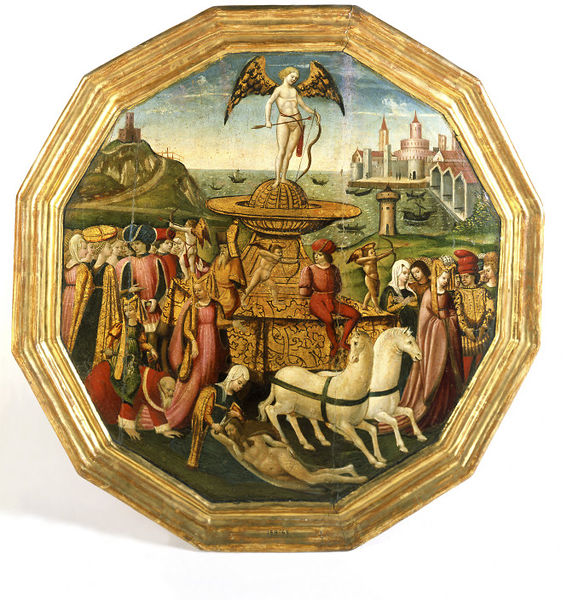

Эти подносы были важным символическим подарком по случаю успешного рождения ребенка в Тоскане: Флоренции и Сиене, примерно 1380 до 1520гг.
Беременность и роды были очень опасными в те времена, как пишут- почти пятая часть родов заканчивалась неудачно.


Младенческая смертность была очень высокой и успешные роды торжественно праздновали, а счастливым матерям приносили на этих подносах и в вазах угощения и вино.
После родов эти подносы и вазы служили памятным украшением дома.
=============Childbirth Tray (Desco da Parto)==================

Artista fiorentino, desco da parto con diana e atteone e, sul retro, la giustizia, 1395 ca.
Они и другие специальные вещи для младенца и матери, как вышитые подушки- держали долгое время после успешного рождения в семьях всех классов: от аристократии до ремесленников и купцов. Более дорогие заказывали у художников- тех же, что расписывали свадебные сундуки-кассоне.
Что интересно- можно было купить готовый полуфабрикат, с пустыми окнами для фамильного герба, а у кого средства были ограничены- могли купить подержанные, или заказать у менее известного мастера.
Формат их, как правило, от 50 до 60 см в поперечнике, с двенадцатью или шестнадцать сторонами, или круглые. Самыми популярными сюжетами были: Рождение Богородицы, аллегории и триумфы любви- как и в кассоне. Часто расписывали обе стороны подноса.

Master of Charles of Durazzo (Francesco di Michele?)
Birth Tray (Desco da Parto) with the Triumph of Venus
ca. 1400
Musée du Louvre
---------------Bartolomeo di Fruosino------------
==================================================

Desco da Parto by Bartolomeo di Fruosino
The date along the bottom of this tray - 25 April 1428 - probably records the birth of the child for whom this was made.

The tray is decorated with a birthing scene, with servants and well-wishers bringing the new mother gifts

Bartolomeo di Fruosino
Scena di nascita
desco da parto, Stresa, Isola Bella, Collezione Borromeo

Bartolomeo di Fruosino
Bambino nudo
desco da parto (retro), Stresa, Isola Bella, Collezione Borromeo

Bartolomeo di fruosino, desco da parto
---------------Masaccio------------------

This painting, also known as the Berlin Tondo, is a desco da parto, or birthing-tray painted by the Italian Renaissance artist Masaccio, c. 1427-1428.
Masaccio
----------------Metmuseum---------------
===============================================
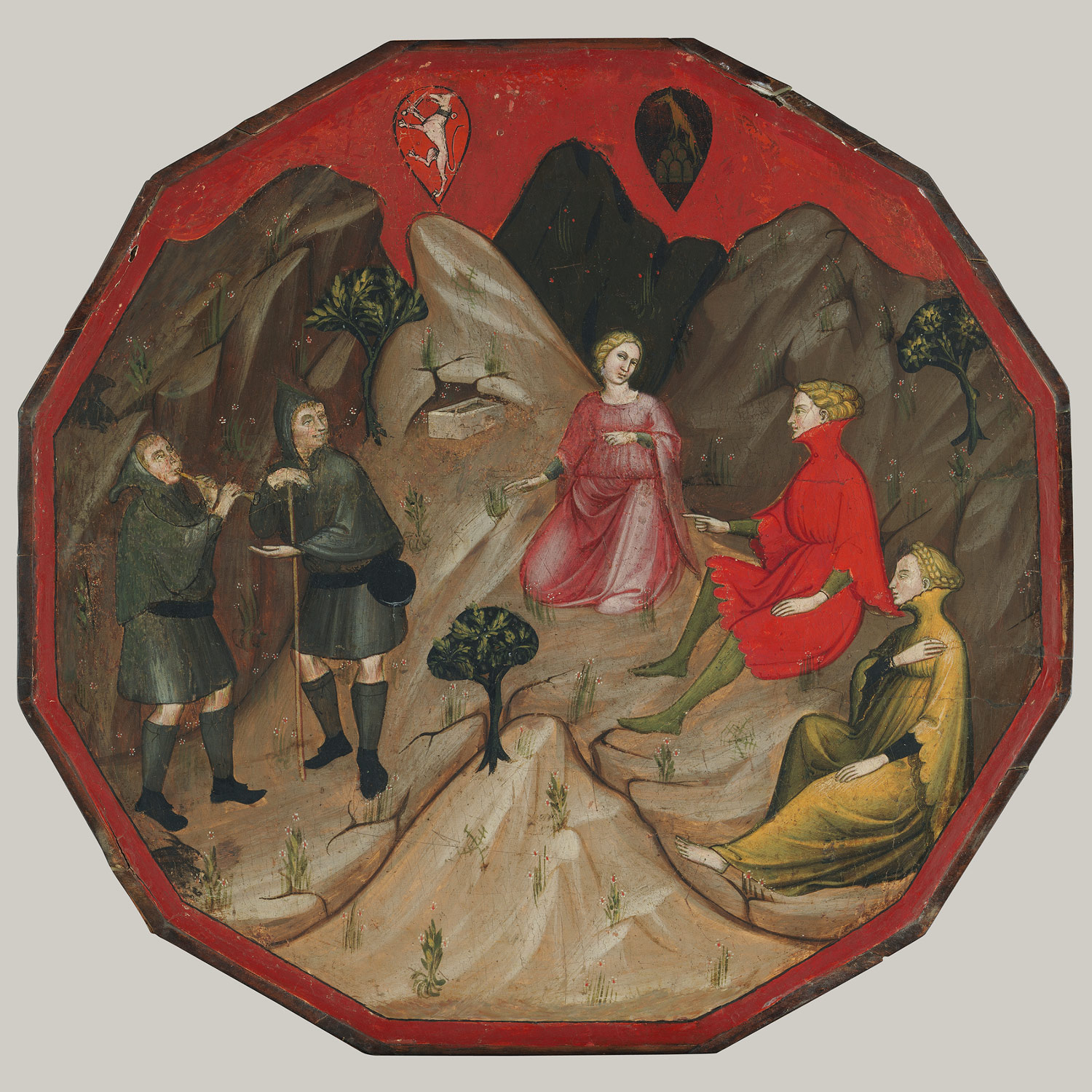
Childbirth tray (desco da parto) with scenes from Boccaccio's Commedia delle ninfe fiorentine: Ameto's Discovery of the Nymphs and Contest between the Shepherds Alcesto and Acaten, ca. 1410
Master of 1416 (Italian, Florentine, active early 15th century)
Tempera on panel Heilbrunn Timeline of Art History | The Metropolitan Museum of Art
-------------Giovanni di Ser Giovanni detto Lo Scheggia-------

Childbirth tray (desco da parto) with the Triumph of Fame (recto) and Medici and Tornabuoni arms and devices (verso), 1448-49
Giovanni di Ser Giovanni Guidi, called Lo Scheggia (Italian, Florentine, 1406-1486)
Tempera, silver, and gold on panel

Childbirth tray (desco da parto) with the Triumph of Fame (recto) and Medici and Tornabuoni arms and devices (verso), 1448-49 (Detail)
New York, Metropolitan Museum
-----------------------------------------

Maestro del giudizio di Paride
Il giudizio di Paride
Firenze, Museo Nazionale del Bargello
-------------------

Lo scheggia, desco da parto col gioco del civettino, pal davanzati
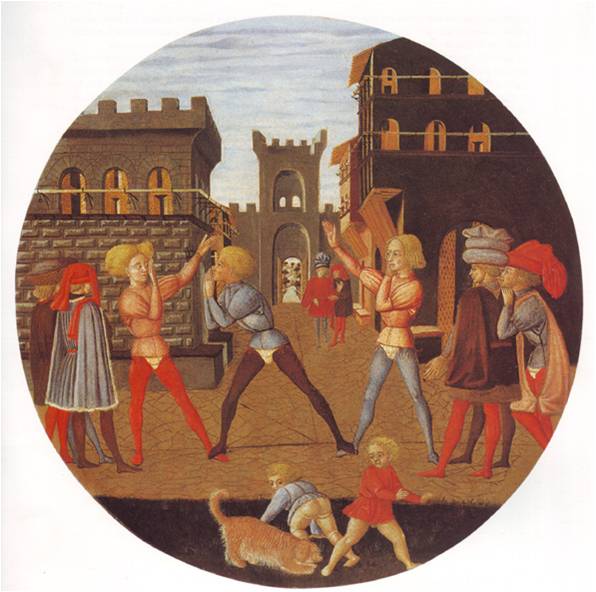
Начало 15 века
scheggia_front-of-civetto
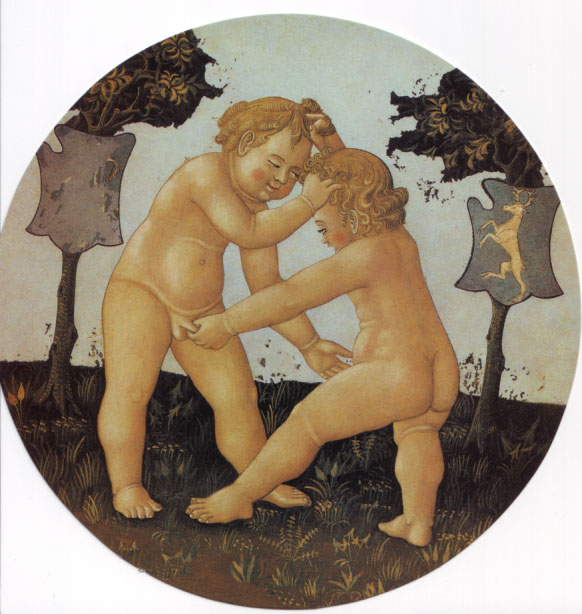
scheggia_back-of-civetto
===========================
-----------------

Scenes from the Legend of David and Goliath
Florentine, c. 1450
Tempera on panel
------------------------------

Desco da Parto (Birth Tray): Scenes from the Legend of David and Goliath, ca. 1440
Italian (Florence)
Tempera on panel
Этих подносов сохранилось немного- около двадцати, и они, как и расписные доски кассоне- висят сейчас в музеях, как самостоятельные картины.
Их можно спутать с тондо- картинами в форме круга или многоугольника.
----------------------тондо-------
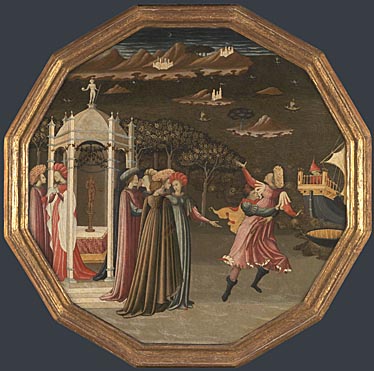
The Abduction of Helen
about 1440-50, Master of the Judgement of Paris

The idea of these tondos came from something called a desco da parto
Что еще делали для рожениц:
----------------tafferie di parto-----------------
====================================================
Это миски- подносы из дерева,были известны как tafferie ди Парто и были украшены сценами рождения. Некоторые из них были основаны на сценах Рождества,или из древнегреческих мифов, как рождение Геракла. Как и в майолике, в орнаменте были арабески и гротескные мотивы, основанные на древнеримских изображениях.
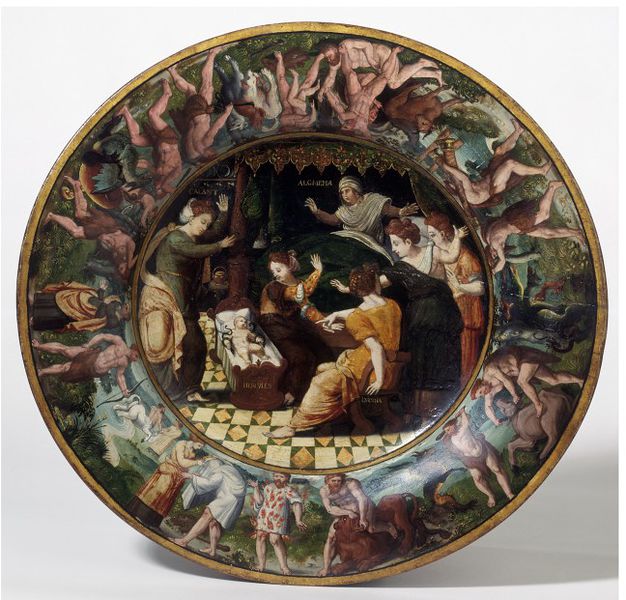
Franco, Giovanni Battista (circle of, painter)
1530-1540 (made)
Turned wooden bowl with painted decoration

Florentine, Childbirth Tray (desco da parto) with The Triumph of Love, circa 1470. Tempera on panel, 18 3/4 in x 19 1/2 in (octagonal). Museum purchase in honor of Lilian Armstrong
Tin-glazed earthenware (maiolica)
------------------Childbirth bowl (scodella) --------
==================================================
Также были блюда и чаши из майолики, специально делавшиеся для этого события.
The scodella da impagliata- термин, используемый для описания взаимосвязанных товаров-подарков для беременных женщин и молодых матерей из майолики.
К 1600 году керамические чаши становятся все более популярными.
Это миски для бульона, вазы для фруктов и сладостей,на которых подавалась еда.
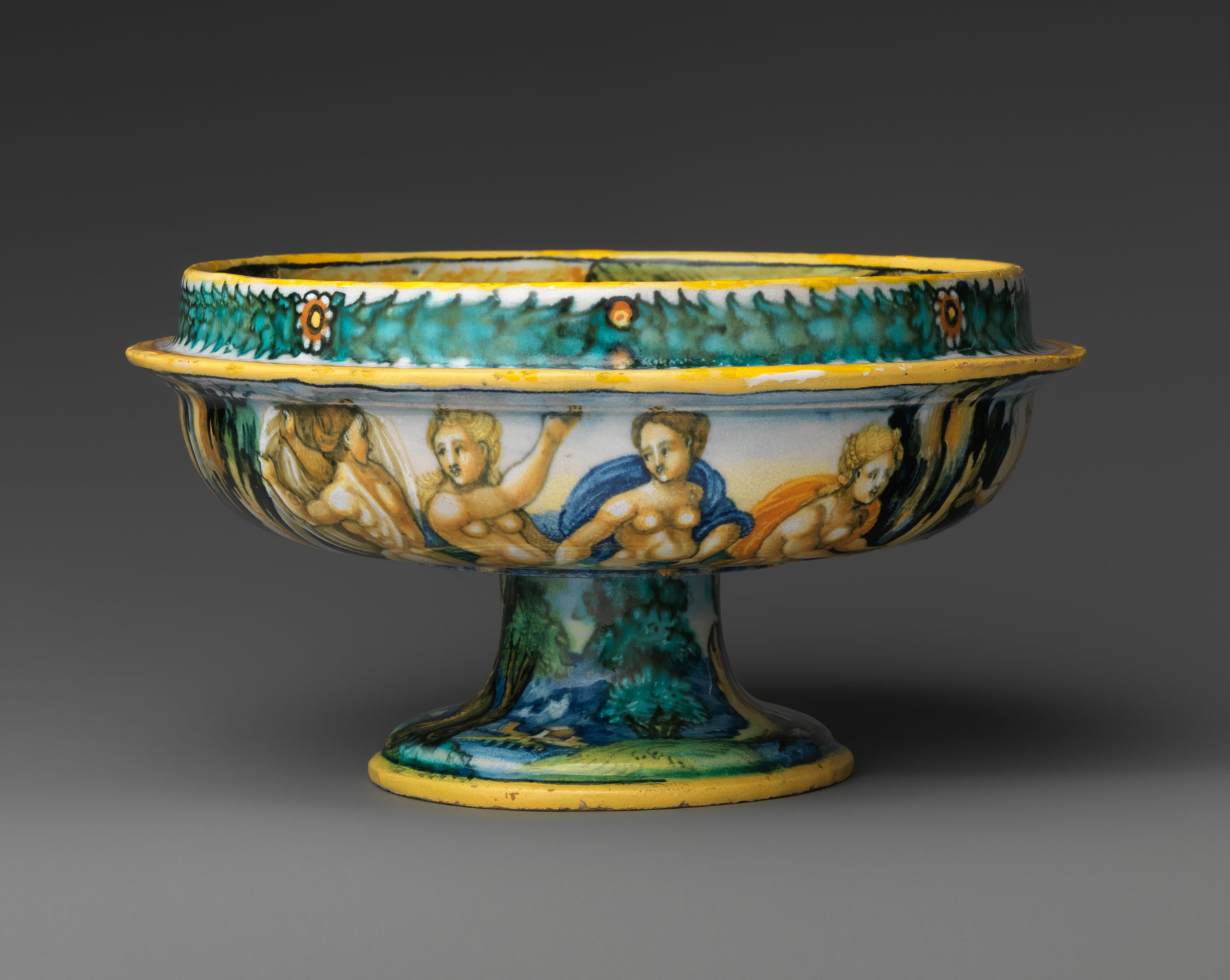
Childbirth bowl (scodella) with confinement-chamber scene (interior) and Diana and Actaeon (exterior), ca. 1530s
Circle of Francesco Xanto Avelli (Italian, ca. 1486-ca. 1582)
Tin-glazed earthenware (maiolica)
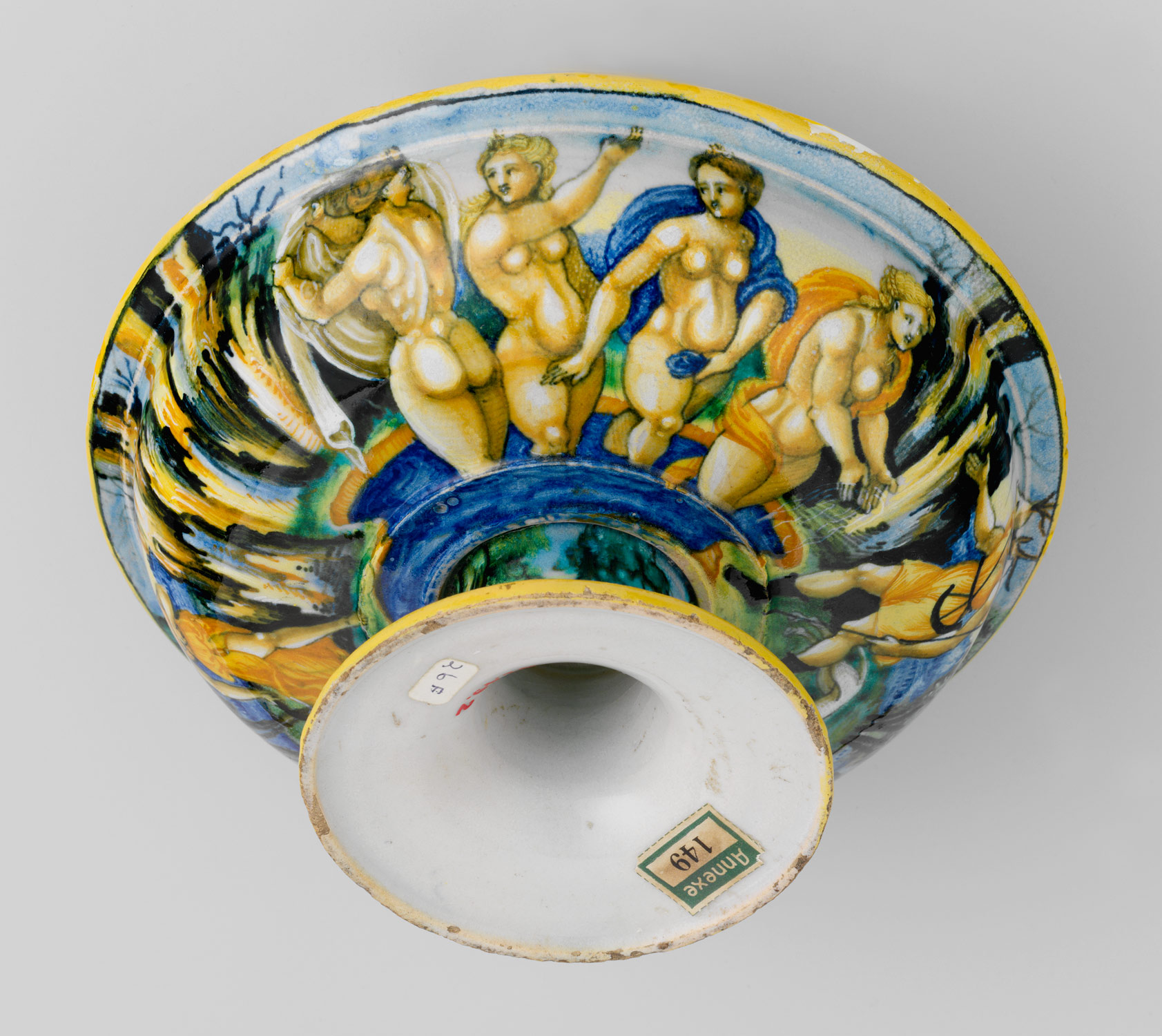
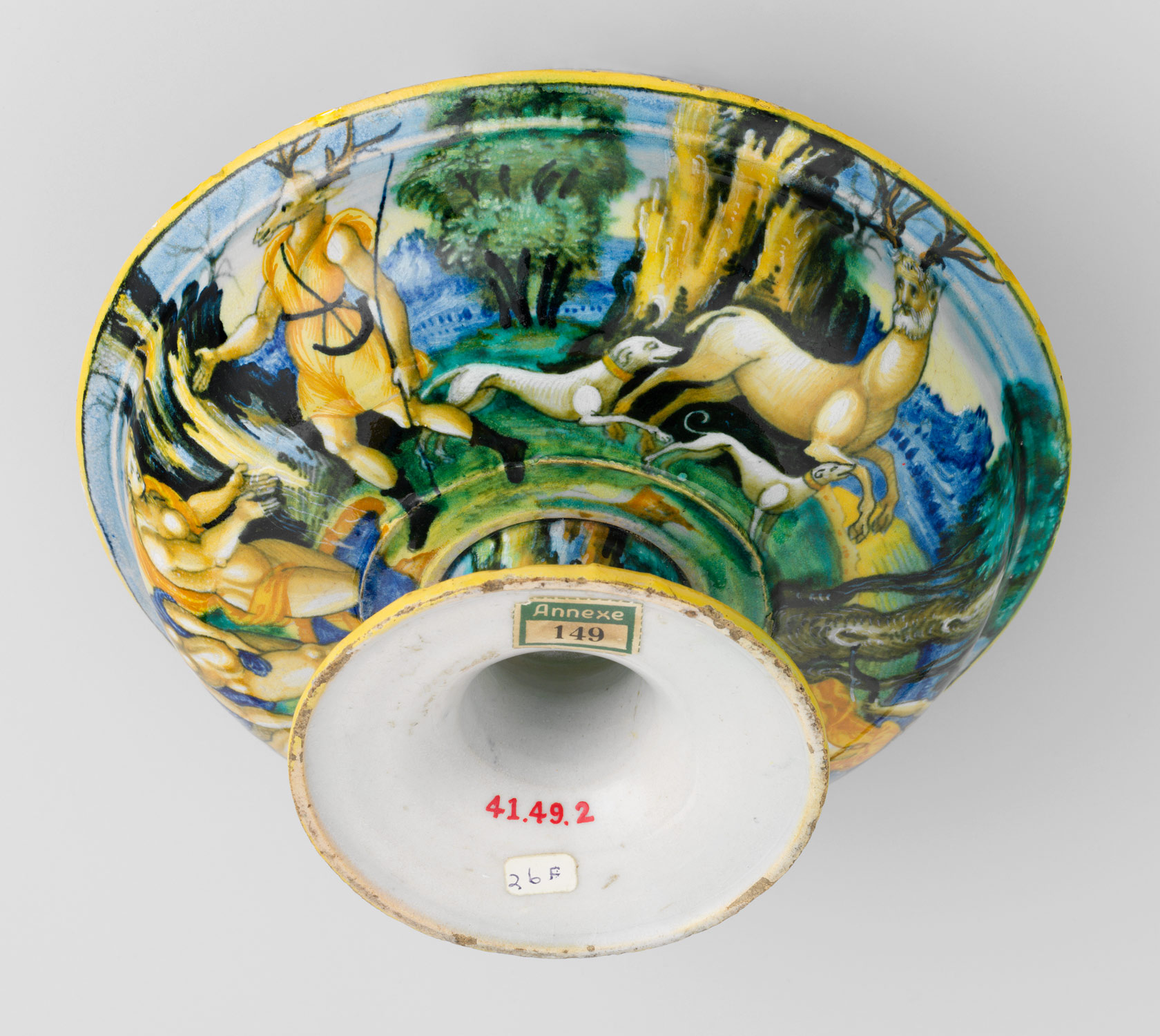
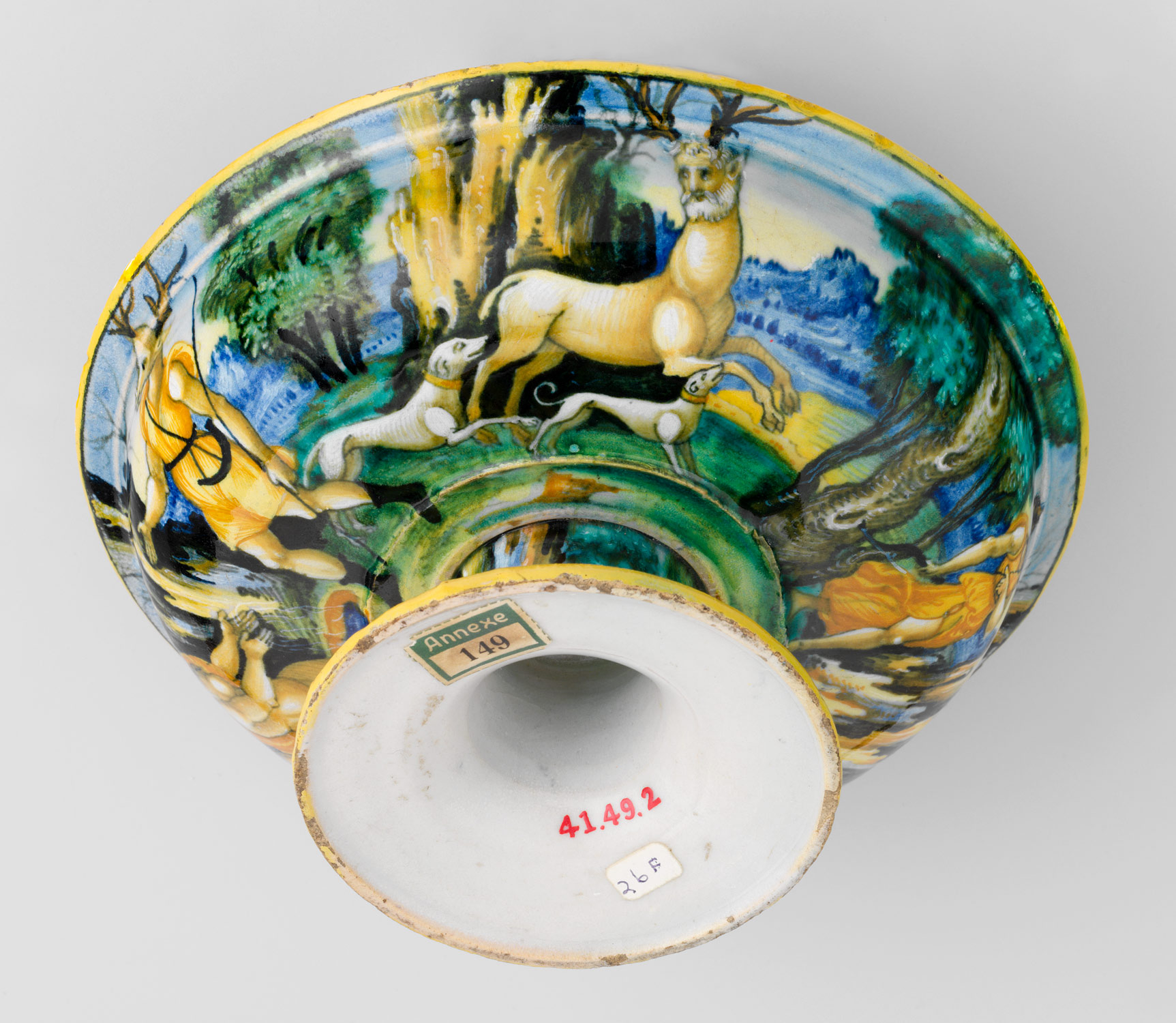
The Metropolitan Museum of Art
--------------------------

Childbirth bowl (scodella) with Aeneas Fleeing Troy (interior) and grotteschi (exterior); and tray (tagliere) with Pyramis and Thisbe (top) and Hercules and the Nemean Lion (bottom), ca. 1530-40
Baldassare Manara (Italian, Faenza, active 1529-46/47)

The Metropolitan Museum of Art

Childbirth bowl (scodella) with Aeneas Fleeing Troy (interior) and grotteschi (exterior); and tray (tagliere) with Pyramis and Thisbe (top) and Hercules and the Nemean Lion (bottom), ca. 1530-40

Baldassare Manara (Italian, Faenza, active 1529-46/47)
Tin-glazed earthenware (maiolica)
The Metropolitan Museum of Art
------------------------

Childbirth Bowl (Scodella) with a Confinement-Chamber Scene (interior) and Landscape (exterior); Childbirth Tray (Tagliere) with a Confinement-Chamber Scene (top) and a Cupid (bottom)
Although this childbirth bowl and tray are not signed and dated, they are most likely the work of the well-documented maiolica painter Francesco Durantino.
--------------------
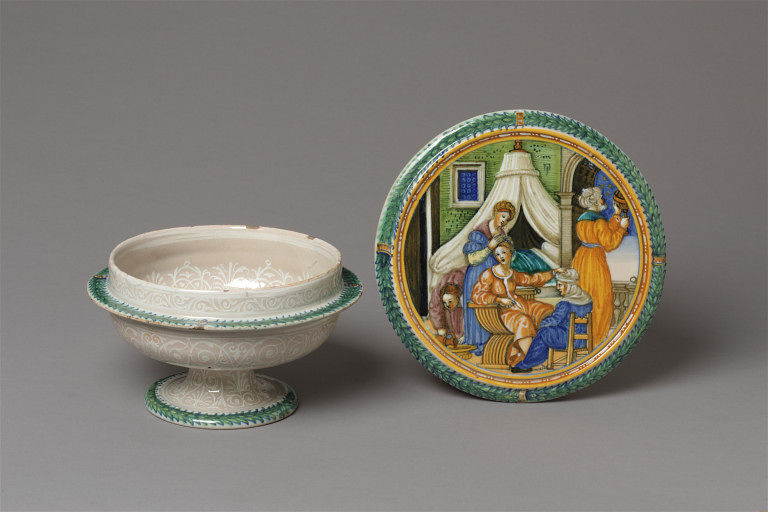
This broth bowl and trencher (a flat plate used to cover a bowl) likely formed part of a more extensive birth set, or scodella da impagliata.
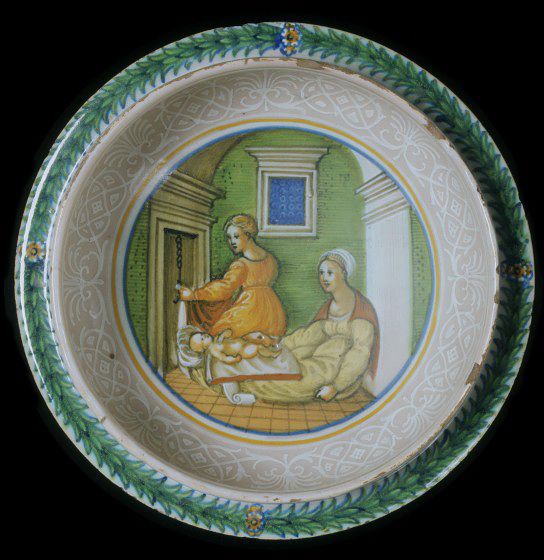
Trencher and bowl
Nicola da Urbino
1533-38

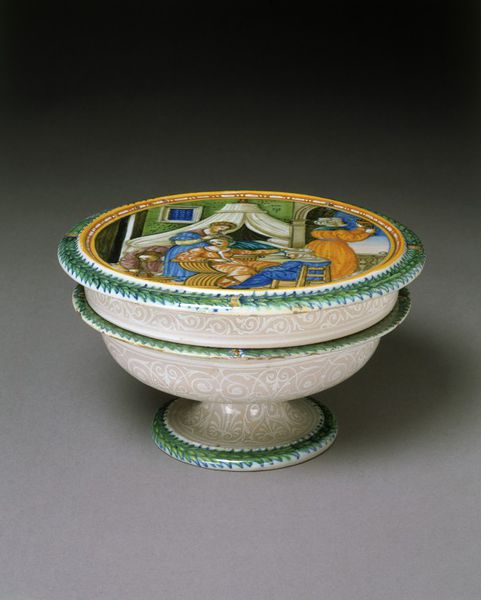
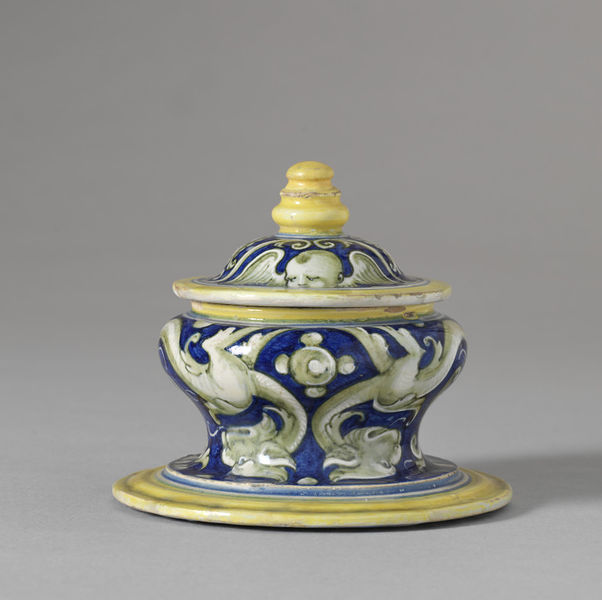
Cолонка из подарочного набора на рождение ребенка.
ca. 1525-1535 (made)
The scodella da impagliata was a term used to describe a composite set of interlocking maiolica wares for pregnant women or new mothers. This salt, likely formed the finial of one such set. The salt within could be used to season the broth, or other specially prepared foods, contained in the bowls below.
Еще по теме:
===========================

Jacopo del Sallaio (1441-1493),Story of Cupid and-Psyche

Bartolomeo di Giovanni.Свадьба -Le nozze di Teti e Peleo
Росписи свадебных сундуков-кассоне.15-16 век-ТУТ


РОДЫ-БЕРЕМЕННОСТЬ-КОНТРАЦЕПЦИЯ, все посты-ТУТ
------------------------
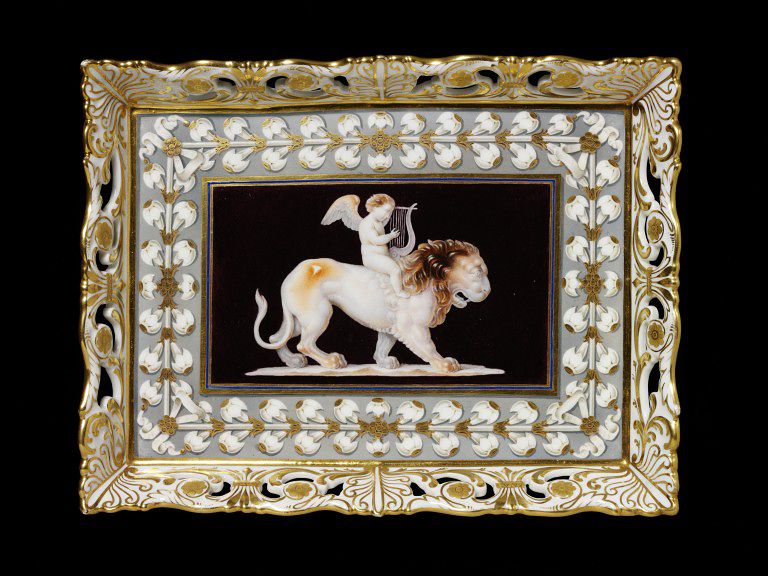
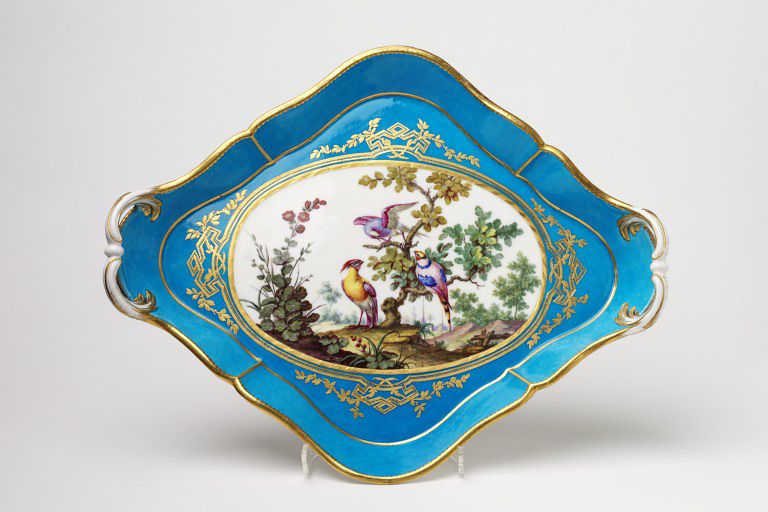
Подносы, все посты-ТУТ
This sumptuous Italian Renaissance birth tray, or desco da parto,commemorated the birth of a child and served an important function in the rituals of Florentine society. Commissioned by the husband, the tray was used to bring sweetmeats and other nourishment to a new mother. Following this ceremonial presentation, the tray became a gift in itself, and would hang in the family home to celebrate the birth. Scenes from the legend of David and Goliath infuse the tray with wishes of courage and bravery for the young child, and his successful future as a civic leader.
After a Florentine mother had given birth, her friends would bring her refreshments on wooden trays or deschi di parto specially painted for the occasion. By 1600, ceramic bowls in maiolica became increasingly popular for this purpose, and so woodworkers and turners produced wooden bowls in imitation, in order to keep up with the fashion. These shallow wooden painted bowls were known as tafferie di parto and were decorated with birth scenes. Some were based on Nativity scenes and others on scenes from ancient Greek myths, like the birth of Hercules, used to decorate this example. Like its maiolica counterparts, the outside of this bowl has been painted with a large arabesque pattern and decorated with 'grotesque' ornament based on ancient Roman decoration.
Birth and Family in the Italian Renaissance
http://www.metmuseum.org/toah/hd/bifa/hd_bifa.htm
http://www.vam.ac.uk/content/articles/r/renaissance-childbirth/
http://www.luc.edu/luma/darcy/david.html
http://collections.vam.ac.uk
http://www.google.ru/search?um=1&hl=ru&newwindow=1&client=firefox&rls=org.mozilla:ru:official&biw=1544&bih=811&ndsp=21&q=Childbirth%20Tray%20%28Desco%20da%20Parto%29&ie=UTF-8&sa=N&tab=iw
http://commons.wikimedia.org/wiki/Category:Desco_da_parto
====================

Portrait of Messer Marsilio Cassotti and His Wife, Faustina, 1523


Эти подносы были важным символическим подарком по случаю успешного рождения ребенка в Тоскане: Флоренции и Сиене, примерно 1380 до 1520гг.
Беременность и роды были очень опасными в те времена, как пишут- почти пятая часть родов заканчивалась неудачно.


Младенческая смертность была очень высокой и успешные роды торжественно праздновали, а счастливым матерям приносили на этих подносах и в вазах угощения и вино.
После родов эти подносы и вазы служили памятным украшением дома.
=============Childbirth Tray (Desco da Parto)==================
Artista fiorentino, desco da parto con diana e atteone e, sul retro, la giustizia, 1395 ca.
Они и другие специальные вещи для младенца и матери, как вышитые подушки- держали долгое время после успешного рождения в семьях всех классов: от аристократии до ремесленников и купцов. Более дорогие заказывали у художников- тех же, что расписывали свадебные сундуки-кассоне.
Что интересно- можно было купить готовый полуфабрикат, с пустыми окнами для фамильного герба, а у кого средства были ограничены- могли купить подержанные, или заказать у менее известного мастера.
Формат их, как правило, от 50 до 60 см в поперечнике, с двенадцатью или шестнадцать сторонами, или круглые. Самыми популярными сюжетами были: Рождение Богородицы, аллегории и триумфы любви- как и в кассоне. Часто расписывали обе стороны подноса.

Master of Charles of Durazzo (Francesco di Michele?)
Birth Tray (Desco da Parto) with the Triumph of Venus
ca. 1400
Musée du Louvre
---------------Bartolomeo di Fruosino------------
==================================================

Desco da Parto by Bartolomeo di Fruosino
The date along the bottom of this tray - 25 April 1428 - probably records the birth of the child for whom this was made.
The tray is decorated with a birthing scene, with servants and well-wishers bringing the new mother gifts

Bartolomeo di Fruosino
Scena di nascita
desco da parto, Stresa, Isola Bella, Collezione Borromeo

Bartolomeo di Fruosino
Bambino nudo
desco da parto (retro), Stresa, Isola Bella, Collezione Borromeo

Bartolomeo di fruosino, desco da parto
---------------Masaccio------------------

This painting, also known as the Berlin Tondo, is a desco da parto, or birthing-tray painted by the Italian Renaissance artist Masaccio, c. 1427-1428.
Masaccio
----------------Metmuseum---------------
===============================================

Childbirth tray (desco da parto) with scenes from Boccaccio's Commedia delle ninfe fiorentine: Ameto's Discovery of the Nymphs and Contest between the Shepherds Alcesto and Acaten, ca. 1410
Master of 1416 (Italian, Florentine, active early 15th century)
Tempera on panel Heilbrunn Timeline of Art History | The Metropolitan Museum of Art
-------------Giovanni di Ser Giovanni detto Lo Scheggia-------

Childbirth tray (desco da parto) with the Triumph of Fame (recto) and Medici and Tornabuoni arms and devices (verso), 1448-49
Giovanni di Ser Giovanni Guidi, called Lo Scheggia (Italian, Florentine, 1406-1486)
Tempera, silver, and gold on panel

Childbirth tray (desco da parto) with the Triumph of Fame (recto) and Medici and Tornabuoni arms and devices (verso), 1448-49 (Detail)
New York, Metropolitan Museum
-----------------------------------------

Maestro del giudizio di Paride
Il giudizio di Paride
Firenze, Museo Nazionale del Bargello
-------------------

Lo scheggia, desco da parto col gioco del civettino, pal davanzati

Начало 15 века
scheggia_front-of-civetto

scheggia_back-of-civetto
===========================
-----------------

Scenes from the Legend of David and Goliath
Florentine, c. 1450
Tempera on panel
------------------------------

Desco da Parto (Birth Tray): Scenes from the Legend of David and Goliath, ca. 1440
Italian (Florence)
Tempera on panel
Этих подносов сохранилось немного- около двадцати, и они, как и расписные доски кассоне- висят сейчас в музеях, как самостоятельные картины.
Их можно спутать с тондо- картинами в форме круга или многоугольника.
----------------------тондо-------

The Abduction of Helen
about 1440-50, Master of the Judgement of Paris

The idea of these tondos came from something called a desco da parto
Что еще делали для рожениц:
----------------tafferie di parto-----------------
====================================================
Это миски- подносы из дерева,были известны как tafferie ди Парто и были украшены сценами рождения. Некоторые из них были основаны на сценах Рождества,или из древнегреческих мифов, как рождение Геракла. Как и в майолике, в орнаменте были арабески и гротескные мотивы, основанные на древнеримских изображениях.

Franco, Giovanni Battista (circle of, painter)
1530-1540 (made)
Turned wooden bowl with painted decoration

Florentine, Childbirth Tray (desco da parto) with The Triumph of Love, circa 1470. Tempera on panel, 18 3/4 in x 19 1/2 in (octagonal). Museum purchase in honor of Lilian Armstrong
Tin-glazed earthenware (maiolica)
------------------Childbirth bowl (scodella) --------
==================================================
Также были блюда и чаши из майолики, специально делавшиеся для этого события.
The scodella da impagliata- термин, используемый для описания взаимосвязанных товаров-подарков для беременных женщин и молодых матерей из майолики.
К 1600 году керамические чаши становятся все более популярными.
Это миски для бульона, вазы для фруктов и сладостей,на которых подавалась еда.

Childbirth bowl (scodella) with confinement-chamber scene (interior) and Diana and Actaeon (exterior), ca. 1530s
Circle of Francesco Xanto Avelli (Italian, ca. 1486-ca. 1582)
Tin-glazed earthenware (maiolica)



The Metropolitan Museum of Art
--------------------------

Childbirth bowl (scodella) with Aeneas Fleeing Troy (interior) and grotteschi (exterior); and tray (tagliere) with Pyramis and Thisbe (top) and Hercules and the Nemean Lion (bottom), ca. 1530-40
Baldassare Manara (Italian, Faenza, active 1529-46/47)

The Metropolitan Museum of Art

Childbirth bowl (scodella) with Aeneas Fleeing Troy (interior) and grotteschi (exterior); and tray (tagliere) with Pyramis and Thisbe (top) and Hercules and the Nemean Lion (bottom), ca. 1530-40

Baldassare Manara (Italian, Faenza, active 1529-46/47)
Tin-glazed earthenware (maiolica)
The Metropolitan Museum of Art
------------------------

Childbirth Bowl (Scodella) with a Confinement-Chamber Scene (interior) and Landscape (exterior); Childbirth Tray (Tagliere) with a Confinement-Chamber Scene (top) and a Cupid (bottom)
Although this childbirth bowl and tray are not signed and dated, they are most likely the work of the well-documented maiolica painter Francesco Durantino.
--------------------

This broth bowl and trencher (a flat plate used to cover a bowl) likely formed part of a more extensive birth set, or scodella da impagliata.

Trencher and bowl
Nicola da Urbino
1533-38



Cолонка из подарочного набора на рождение ребенка.
ca. 1525-1535 (made)
The scodella da impagliata was a term used to describe a composite set of interlocking maiolica wares for pregnant women or new mothers. This salt, likely formed the finial of one such set. The salt within could be used to season the broth, or other specially prepared foods, contained in the bowls below.
Еще по теме:
===========================

Jacopo del Sallaio (1441-1493),Story of Cupid and-Psyche

Bartolomeo di Giovanni.Свадьба -Le nozze di Teti e Peleo
Росписи свадебных сундуков-кассоне.15-16 век-ТУТ


РОДЫ-БЕРЕМЕННОСТЬ-КОНТРАЦЕПЦИЯ, все посты-ТУТ
------------------------


Подносы, все посты-ТУТ
This sumptuous Italian Renaissance birth tray, or desco da parto,commemorated the birth of a child and served an important function in the rituals of Florentine society. Commissioned by the husband, the tray was used to bring sweetmeats and other nourishment to a new mother. Following this ceremonial presentation, the tray became a gift in itself, and would hang in the family home to celebrate the birth. Scenes from the legend of David and Goliath infuse the tray with wishes of courage and bravery for the young child, and his successful future as a civic leader.
After a Florentine mother had given birth, her friends would bring her refreshments on wooden trays or deschi di parto specially painted for the occasion. By 1600, ceramic bowls in maiolica became increasingly popular for this purpose, and so woodworkers and turners produced wooden bowls in imitation, in order to keep up with the fashion. These shallow wooden painted bowls were known as tafferie di parto and were decorated with birth scenes. Some were based on Nativity scenes and others on scenes from ancient Greek myths, like the birth of Hercules, used to decorate this example. Like its maiolica counterparts, the outside of this bowl has been painted with a large arabesque pattern and decorated with 'grotesque' ornament based on ancient Roman decoration.
Birth and Family in the Italian Renaissance
http://www.metmuseum.org/toah/hd/bifa/hd_bifa.htm
http://www.vam.ac.uk/content/articles/r/renaissance-childbirth/
http://www.luc.edu/luma/darcy/david.html
http://collections.vam.ac.uk
http://www.google.ru/search?um=1&hl=ru&newwindow=1&client=firefox&rls=org.mozilla:ru:official&biw=1544&bih=811&ndsp=21&q=Childbirth%20Tray%20%28Desco%20da%20Parto%29&ie=UTF-8&sa=N&tab=iw
http://commons.wikimedia.org/wiki/Category:Desco_da_parto
====================